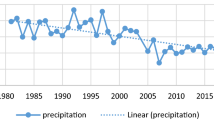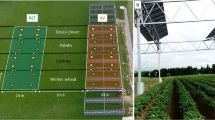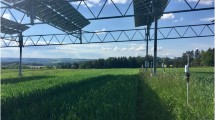Abstract
The objective of this work was to develop and evaluate agrometeorological models to simulate the production of Guineagrass. For this purpose, we used forage yield from 54 growing periods between December 2004–January 2007 and April 2010–March 2012 in irrigated and non-irrigated pastures in São Carlos, São Paulo state, Brazil (latitude 21°57′42″ S, longitude 47°50′28″ W and altitude 860 m). Initially we performed linear regressions between the agrometeorological variables and the average dry matter accumulation rate for irrigated conditions. Then we determined the effect of soil water availability on the relative forage yield considering irrigated and non-irrigated pastures, by means of segmented linear regression among water balance and relative production variables (dry matter accumulation rates with and without irrigation). The models generated were evaluated with independent data related to 21 growing periods without irrigation in the same location, from eight growing periods in 2000 and 13 growing periods between December 2004–January 2007 and April 2010–March 2012. The results obtained show the satisfactory predictive capacity of the agrometeorological models under irrigated conditions based on univariate regression (mean temperature, minimum temperature and potential evapotranspiration or degreedays) or multivariate regression. The response of irrigation on production was well correlated with the climatological water balance variables (ratio between actual and potential evapotranspiration or between actual and maximum soil water storage). The models that performed best for estimating Guineagrass yield without irrigation were based on minimum temperature corrected by relative soil water storage, determined by the ratio between the actual soil water storage and the soil water holding capacity.irrigation in the same location, in 2000, 2010 and 2011. The results obtained show the satisfactory predictive capacity of the agrometeorological models under irrigated conditions based on univariate regression (mean temperature, potential evapotranspiration or degree-days) or multivariate regression. The response of irrigation on production was well correlated with the climatological water balance variables (ratio between actual and potential evapotranspiration or between actual and maximum soil water storage). The models that performed best for estimating Guineagrass yield without irrigation were based on degree-days corrected by the water deficit factor.





Similar content being viewed by others
References
Addiscott TM, Whitmore AP (1987) Computer simulation of changes in soil mineral nitrogen and crop nitrogen during autumn, winter and spring. J Agric Sci 109:141–157
Akaike H (1974) A new look at the statistical model identification. IEEE Trans Autom Control 9(6):716–723
Bachinger J, Reining E (2009) An empirical statistical model for predicting the yield of herbage from legume-grass swards within organic crop rotations based on cumulative water balances. Grass Forage Sci 64:144–159. doi:10.1111/j.1365-2494.2009.00678.x
Barioni LG, Ramos AKB, Martha GB Jr, Ferreira AC, Silva FAM, Vilela L, Veloso RF (2005) Orçamentação forrageira e Ajustes em Taxas de Lotação. In: Pedreira CGS, Moura JC, Silva SC, Faria VD (eds) Simpósio sobre manejo da pastagem. FEALQ, Piracicaba, pp 217–245
Cooper JP, Tainton NM (1968) Light and temperature requirements for growth of tropical and temperate grasses. Herbage Abstr 38:167–176
Cruz PG, Santos PM, Pezzopane JRM, Oliveira PPA, Araujo LC (2011) Modelos empíricos para estimar o acúmulo de matéria seca de capim-marandu com variáveis agrometeorológicas. Pesq Agrop Brasileira 46:675–681. doi:10.1590/S0100-204X2011000700001
Detomini ER, Coelho RD, Monteiro ROC (2005) Avaliação da produção de Panicum maximum cv. Tanzânia sob diferentes níveis de oferta ambiental. Pasturas Tropicales 27:26–37
IBGE, Instituto Brasileiro de Geografia e Estatística (2006) Censo agropecuário 2006: Brasil, grandes regiões e unidades da federação. IBGE, Rio de Janeiro
Keating BA, Carberry PS, Hammer GL, Probert ME, Robertson MJ, Holzworth D, Huth NI, Hargreaves JNG, Meinke H, Hochman Z, Mclean G, Verburg K, Snow V, Dimes JP, Silburn M, Wang E, Brown S, Bristow KL, Asseng S, Chapman S, Mccown RL, Freebairn DM, Smith CJ (2003) An overview of APSIM, a model designed for farming systems simulation. Eur J Agron 18:267–288. doi:10.1016/S1161-0301(02)00108-9
Lara MAS, Pedreira CGS, Boote KJ, Pedreira BC, Moreno LSB, Alderman PD (2012) Predicting growth of Panicum maximum: an adaptation of the CROPGRO-forage model. Agron J 104:600–611. doi:10.2134/agronj2011.0272
Littell RC, Stroup WW, Freund RJ (2002) Sas for linear models, 3rd edn. SAS Institute, Cary
Moir JL, Scotter DR, Hedley MJ (2000) A climate-driven, soil fertility dependent, pasture production model. N Z J Agric Res 43:491–511
Müller MS, Fancelli AL, Dourado Neto D, Garcia AG, Ovejero RFL (2002) Produtividade do Panicum maximum cv. Mombaça irrigado, sob pastejo rotacionado. Sci Agric 59(3):427–433. doi:10.1590/S0103-90162002000300003
Pedreira CGS, Tonato F, Lara MAS (2009) Forrageiras: Brachiaria, Panicum e Cynodon. In: Monteiro JEBA (ed) Agrometeorologia dos cultivos: o fator meteorológico na produção agrícola. INMET, Brasília, pp 426–447
Pedreira BC, Pedreira CGS, Boote KJ, Lara MAS, Alderman PD (2011) Adapting the CROPGRO perennial forage model to predict growth of Brachiaria brizantha. Field Crop Res 120:370–379. doi:10.1016/j.fcr.2010.11.010
Pedro MJ Jr (1995) Índices climáticos de crescimento para gramíneas forrageiras no estado de São Paulo. Bragantia 54(2):427–435
Pezzopane JRM, Santos PM, Mendonça FC, Araujo LC, Cruz PG (2012) Dry matter production of Tanzania grass as a function of agrometeorological variables. Pesq Agrop Brasileira 47:471–477. doi:10.1590/S0100-204X2012000400001
Rassini JB (2002) Manejo da água na irrigação da alfafa em latossolo vermelho-amarelo. Pesq Agrop Brasileira 37(4):503–507. doi:10.1590/S0100-204X2002000400012
Rassini JB (2004) Período de estacionalidade de produção de pastagens irrigadas. Pesq Agrop Brasileira 39(8):821–825. doi:10.1590/S0100-204X2004000800014
Santos FG, Chaves MA, Franco IL, Soares RD, Pinho BD (2008) Índice climático de crescimento para os capins Brachiaria brizantha cv. Marandu, Cynodon dactylon cv. Tifton 85 e Panicum maximum cv. Tanzânia e relação com a produção de matéria seca. Ciênc Anim Bras 9:627–637
SAS (2002/2003) SAS/INSIGHT User’s Guide, versão 9.1.3, versão para Windows. SAS Institute, Cary,
Silva CE, Santos PM, Costa C, Meirelles PRL, Silva BA, Factori MA (2007) Produção e composição morfológica do capim-tanzânia sob pastejo com e sem irrigação. Bol Ind Anim 64:321–328
Soil Survey Staff (1999) Soil taxonomy: a basic system of soil classification for making and interpreting soil surveys (2nd edn). US Department of Agriculture Soil Conservation Service, Washington DC
Thornthwaite CW (1948) An approach toward a rational classification of climate. Geogr Rev 38:55–94
Thornthwaite CW, Mather JR (1955) The water balance. Publications in climatology. Drexel Institute of Technology, New Jersey
Tonato F, Barioni LG, Pedreira CGS, Dantas OD, Malaquias JV (2010) Desenvolvimento de modelos preditores de acúmulo de forragem em pastagens tropicais. Pesq Agrop Brasileira 45:522–529
Trnka M, Eitzinger J, Gruszczynski G, Buchgraber K, Resch R, Schaumberger A (2006) A simple statistical model for predicting herbage production from permanent grassland. Grass Forage Sci 61:253–271
Villa Nova NA, Detomini ER, Dourado Neto D, Pilau FG, Pedreira CGS (2005) Avaliação da produtividade potencial de Brachiaria ruziziensis em função de unidades fototérmicas. Rev Bras Agrometeorol 13(3):443–449
Willmott CJ (1981) On the validation of models. Phys Geogr 2:184–194
Zhang B, Valentine I, Kemp P, Lambert G (2007) Predictive modelling of hill-pasture productivity: integration of a decision tree and a geographical information system. Agric Syst 87:1–17
Acknowledgments
To Conselho Nacional de Desenvolvimento Científico e Tecnológico, for financial support.
Author information
Authors and Affiliations
Corresponding author
Rights and permissions
About this article
Cite this article
Pezzopane, J.R.M., da Cruz, P.G., Santos, P.M. et al. Simple agrometeorological models for estimating Guineagrass yield in Southeast Brazil. Int J Biometeorol 58, 1479–1487 (2014). https://doi.org/10.1007/s00484-013-0751-y
Received:
Revised:
Accepted:
Published:
Issue Date:
DOI: https://doi.org/10.1007/s00484-013-0751-y




